This flower is named after Irida, the goddess of the rainbow. Iris affects not only the variety of colors and shades, but also the many species, the care of which differs from each other. Therefore, before answering the question: how to plant irises, you must first determine what type it belongs to.
Material Content:
Features of growing irises
The iris genus has about 800 species. They are divided into bearded and not bearded. According to the structure of the root system, bulbous and rhizome varieties are distinguished. According to the requirements for moisture and other growing conditions, they are very different.
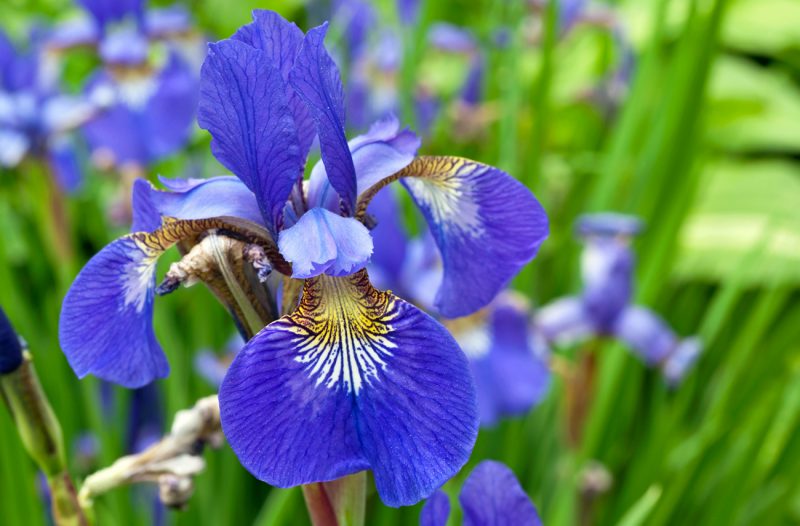
Most often, in the climatic conditions of the middle strip, the following species are grown:
- German Iris. He loves the sun and moderate amounts of moisture. Long flowering. There are also repairing varieties that can bloom repeatedly in the second half of summer.
- Unpretentiousness to growing conditions stands out Siberian iris. A place under the trees is suitable for him, which will cover him from too bright sunlight. Soil prefers moist, but excessive moisture causes disease. Siberian iris belongs to beardless and is the most frost-resistant of all species.
- Japanese or xiphoid irises love the sun and moisture, but without stagnation of water. They are not too winter-hardy, so their cultivation in our climate is associated with a certain risk.
- Bulbous irises come from the Netherlands, so these sissies winter with us only under shelter and are not suitable for cultivation in regions with severe winters. Species and varietal diversity of bulbous irises is great: iris net or iridodictium, xyphium, juno.Each of these species has many varieties. They differ not only in color and height, but also in terms of flowering.
- Iris Chrysographis. A group of irises, opened recently. They come from China and are just starting to win the hearts of flower growers with their unusual speckled flowers.
- Iris swamp. It is most often used for decorating ponds, as it loves to grow in water. In height, it can reach 1.5 m. The variety of colors does not differ: the flowers are painted in shades of yellow.
Each species of irises is planted in due time.
Outdoor landing

Florists have a rule: plants blooming in the spring are transplanted in the second half of summer or autumn. It applies to most irises.
How and when to plant?
German iris can be planted in spring before flowering, in summer and autumn after flowering. But planting irises in the fall for this species is preferable. For planting the Japanese group, the end of summer or the beginning of autumn, but long before the onset of frost, is most suitable. If these weakly resistant plants do not have time to take root, then they are guaranteed to freeze in the winter.
Siberian irises are planted from the second half of August to the end of September, and in warm regions in October. These resistant plants are not afraid of frost.
Reticulated irises are planted in mid-summer. Juno bulbs are dug up at the end of June and stored in a dry place, without picking the roots until September, at which time they are planted. Xyphium bulbs are dug up after the leaves fade, dried and stored in the winter in the refrigerator, planted in the spring.
Depth of landing is also different for different species.
- German irises love a shallow landing. Rhizomes are only slightly sprinkled with earth.
- Japanese and Siberian irises are buried by 5-8 cm.
- Bulbous irises are planted at about the same depth.
Site Preparation and Landing
Some types of irises, such as German ones, grow very quickly, so they are transplanted every 3-4 years. Siberian people are long-lived and can grow in one place for decades, so when planting, you need to provide a place for them to grow.
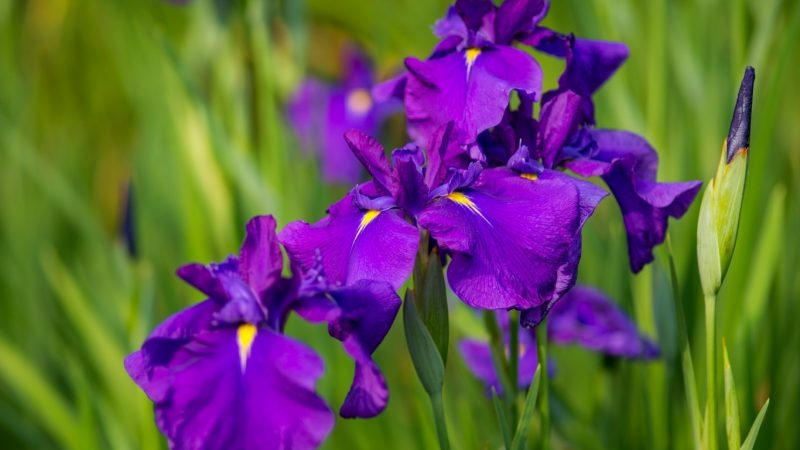
Soil preparation for all types of irises consists in a thorough digging, during which all weed roots, even the smallest, are selected. This is especially true for wheatgrass and dreams. It will be impossible to remove them from the iris jacket without damaging the roots. Some gardeners, to remove all the roots of weeds, sift the land for planting through a sieve.
We will tell in more detail about the most common group - irises of Germanic or bearded. The place for their landing is sunny. Perhaps a slight shade in the afternoon. In complete shading, these plants can also grow, but there will be problems with flowering. A strong wind is also undesirable on the landing site - it can easily break off flower stalks. German irises are prone to getting wet, so places where water accumulates in the spring and wet areas are not suitable for them.
The soil should not be heavy. Sand and compost should be added to clay soil. Soil acidity is adjusted in advance - for irises, earth with a neutral reaction is needed. The soil should be fertile, so it is seasoned with humus in a small amount, adding phosphorus-potassium mineral fertilizer and ash. To avoid root rot, the soil is shed with a fungicide solution.
Manure cannot be added to the ground for planting irises; the roots of these flowers burn from it.
Landing Nuances
In order for this sunny flower to please the grower with health and flowering for a long time, you need to choose the right planting material.
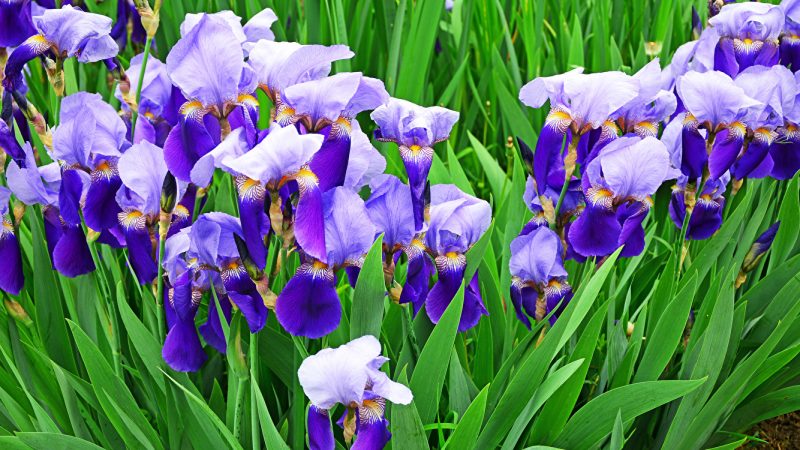
The planted dividend must meet the following criteria:
- the rhizome must have at least one fully formed link, the leaves must be cut to a height of 15 cm;
- dense and elastic rhizome should not have signs of decay;
- the light rhizome has a uniform color and tubercles, which are the beginnings of future roots.
It is advisable to dry the newly dug plants in the shade for one day, cutting off part of the leaves 1/3 of the height.
Then proceed as follows:
- shorten long roots to 10 cm and completely cut off damaged ones; places of damage and sections are cauterized with potassium permanganate;
- prepare holes or grooves with a depth of about 20 cm;
- half fill them with sand;
- the distance between them should not be less than 40 cm, since this type of iris grows rapidly;
- lay rhizomes, spreading the roots on the sides; the plant itself should be strictly vertical;
- fall asleep with soil, taking into account that its layer should be thin, and the upper part of the rhizome should protrude above the ground;
- gently water the plants without eroding the soil;
- in hot weather, watered every day for a week.
Planting irises in the fall has some features. To do this, choose rhizomes with a length of not more than 6 cm and a thickness of not more than 3 cm. Each of them should have a formed flower bud. It must be remembered that during the autumn planting next year, irises may not bloom.
To achieve good flowering plants need to be properly looked after.
Irises: rules for leaving

Caring for German irises is not particularly difficult. These flowers are distinguished by their great vitality and easily forgive gardeners for errors in compliance with the rules of agricultural technology.
Temperature mode
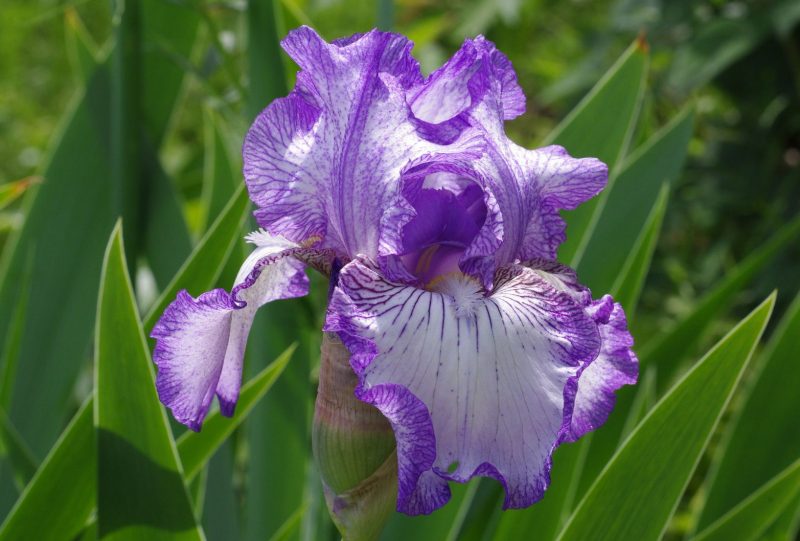
The flower grower has no power over the weather, so plants have to endure the temperature that nature provides. In hot climates, it is necessary to provide for partial shading in the heat, choosing a place when landing.
Watering plants
German irises love water, but cannot stand waterlogging. On moist soils, they need to provide drainage so that the water at the roots does not stagnate. Irises do not like irrigation, so water must be supplied directly to the root zone.
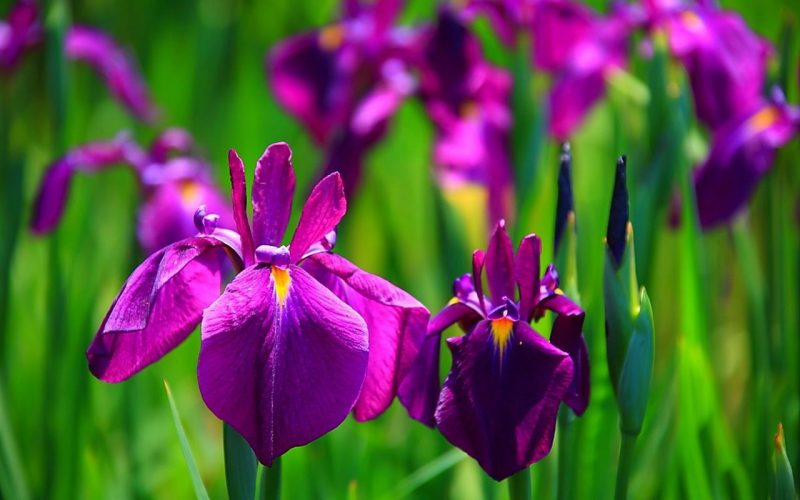
In the warm season, plants are watered regularly, preventing the topsoil from drying out, where the iris roots are located. In late summer and autumn, watering is reduced so that root rot does not develop.
On soils that easily lose moisture, watering is best done in the evening, so that the plants have time to use water to the maximum.
Fertilizer and fertilizer
Some gardeners believe that irises can grow completely without fertilizing, especially if the soil is fertile and well seasoned with nutrients. But still, it will not be amiss to feed flowers, starting from the second year after planting.
Usually do 3 dressings:
- in spring, when growing leaves, you can give nitrogen fertilizer 10 g per square. m; it is good at this time to feed the irises with ash - Art. spoon on the plant;
- after 2-3 weeks, top dressing is done with full mineral fertilizer - 15 g of phosphorus-containing, nitrogen and potassium per 1 sq. km. m;
- during flowering irises need phosphorus and potassium at 20 g per square. m
All dressings must be applied in liquid form, dry fertilizers can burn the surface roots of plants.
Pruning
After flowering, all peduncles are pruned. In August, the leaves are cut to 1/3 of the length. Do the same when planting or transplanting plants.
Transfer
German irises require it quite often. Without it, the flowers become smaller, and the flowering itself becomes weak. With good care, bearded irises grow very quickly, and transplantation may be required already for 4-5 years. The transplant is carried out in the same way as the planting of new plants, dividing the rhizomes into parts and removing rotten and dead ones. Plants are kept in a solution of potassium permanganate for about 15 minutes, then all sections are treated with charcoal.
More materials:iris transplant
Landing of irises to an old place is possible only after 4 years, so that pathogens do not accumulate.
Care in the fall, preparation for winter
In the fall, reduce watering. Remove all diseased and dried leaves, as well as rotted parts of rhizomes. Sprinkle with sand all exposed roots. They mulch the soil around the plants with peat in a layer of 10 cm. If winters are frosty and with little snow, shelter with spruce branches may be necessary, especially for hybrid varieties.
Reproduction of irises
Irises need to be propagated only vegetatively, since sowing seeds does not guarantee that a flower similar to the mother will grow. Propagated in spring, using a one-year link - the process of rhizome with a fan of leaves. It is advisable that their number be at least 7. In this case, the plant will bloom the very next year. You can divide the bush completely by digging it and washing the roots. And you can gently separate part of the rhizome with a fan of leaves, without disturbing the rest of the plant. Sections in all cases are treated with ash or brilliant green. If, at full division, healthy links without leaves are left, they can be grown in the school. Such plants will bloom only in the fifth year.
Sometimes, for the breeding of rare varieties, sleeping kidneys are used. They are cut from the ends of the rhizomes so that the segment forms a wedge. The cut is sprinkled with charcoal. A planted bud wakes up and next year will give a full fan of leaves.
All planting material used for propagation is well dried before planting.
Pests, diseases and methods of dealing with them
Most often, root rot, rust and spotting annoy iris. Dig up the rotten rhizome, remove the damaged areas to a healthy tissue and treat with 2% foundationazole. If the rhizome has rotted completely, the plant is thrown away. Prophylactic treatment with foundationazole will greatly reduce the risk of disease. They are carried out every time the roots are disturbed: during transplantation and reproduction.

To eliminate rust and spotting, plants are treated with 1% Bordeaux liquid in spring and autumn.
Irises have few pests. Against a scoop, biting flower stalks, at the beginning of the growing season, plants are treated with 10% malathion. Do this twice with an interval of 2 weeks.
They fight slugs with metaldehyde in a dosage of 30 g of granules for every 10 square meters. m. You can collect them manually.
In order not to introduce with organics the larvae of May beetles, gnawing roots, humus is sifted. The bear can be scared away by planting marigolds near the irises.
Thrips and spider mites are destroyed by insecticides and acaricides, for example, Fufanon, Actellik, Fitoverm.
Possible growing problems
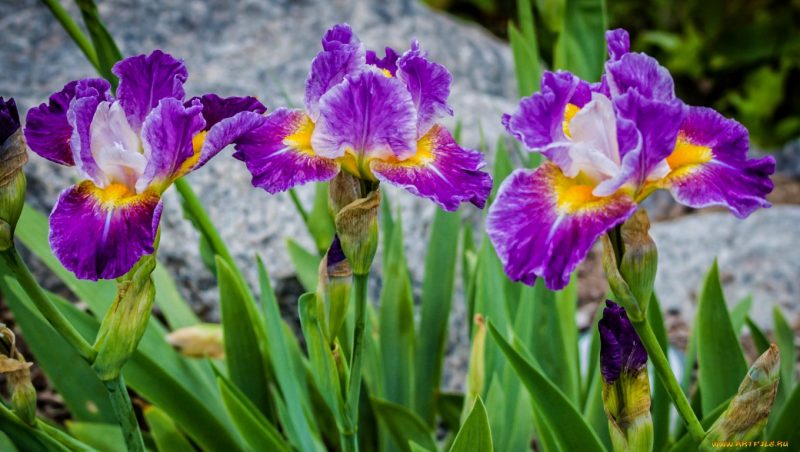
There are few of them.
- There are few leaves in the fan, which is why flowering is delayed. Possible root rot or violation of agricultural technology.
- Irises do not bloom. The following factors may be to blame: too deep a planting, freezing of flower buds in winter, insufficient lighting, and strong overgrowth of rhizomes.
The variety of species and varieties allows any grower to choose an iris to their liking. This bright and majestic flower will become an adornment of any flower garden.












